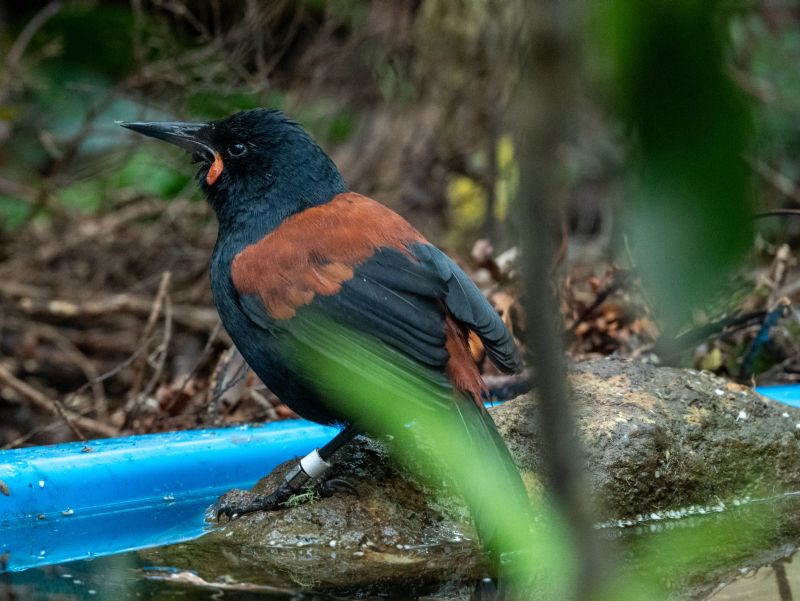The Call of the Tīeke (South Island Saddleback) Returns to Mainland Otago
5 Mar 2025
In a landmark moment for conservation in Aotearoa, the distinctive call of the Tīeke (South Island Saddleback) can be heard once again in Te Wai Pounamu/South Island after a groundbreaking conservation project has successfully returned them to mainland Otago for the first time in over a century.
January 2025 marked a pivotal milestone as Orokonui Ecosanctuary welcomed the first group of these charismatic birds from the Tītī Islands - Putauhinu Island, followed by a second group of 50 birds from Kani (Kundy) Island.
This ambitious translocation project emerged from a partnership between the Rakiura Tītī Islands Administering Body, Kāti Huirapa Rūnaka ki Puketeraki, and Orokonui Ecosanctuary - Te Korowai o Mihiwaka.
"This project highlights the central role of mana whenua as kaitiaki of taonga species," explains Tāne Davis, Chair of the Rakiura Tītī Islands Administrating Body. "It is also a very significant event in the context of protecting and restoring the biodiversity of Aotearoa, and in terms of the central role of mana whenua as kaitiaki of Tīeke and other taonga species."
With only around 2,000 Tīeke remaining in New Zealand, the species faced near-extinction in the 1960’s when rats invaded their last refuge on Taukihepa/Big South Cape Island. Thanks to dedicated conservation efforts and the careful stewardship of mana whenua who manage the Tītī islands, the species gradually recovered, though remained confined to predator-free offshore islands.
The translocation to mainland Otago required meticulous planning and risk management. The project was deferred twice to ensure conditions were perfect for the arrival of these taoka. Additional funding supported enhanced biosecurity measures, including increased trap networks and poison bait operations, as well as preventative tree removal to protect the sanctuary's predator-proof fence.
The genetic diversity between the Kani (Kundy) and Putauhinu birds was carefully considered in the translocation strategy, aimed at establishing a robust breeding population in their new mainland home. "The arrival of this first lot of Tīeke is only the beginning for our team," notes Amanda Symon, General Manager of Orokonui. "Now the real work begins, with monitoring, and other work to ensure these manu thrive here."
Community involvement has been central to the project's success. Over the next two years, volunteers are expected to contribute nearly 3,000 hours to various aspects of the project. These dedicated individuals, including mana whenua and local residents, will assist with crucial tasks such as biosecurity work, bird care in the soft-release aviary, and long-term population monitoring.
Orokonui Ecosanctuary, which welcomes approximately 15,000 visitors annually (60% of whom are local Otago residents), now holds the distinction of being the only mainland location where the public can observe Tīeke in their natural environment. The sanctuary's educational programs will incorporate specific modules about Tīeke conservation, helping to inspire the next generation of conservation advocates.
For Kāti Huirapa Rūnaka ki Puketeraki, the return of the Tīeke holds deep cultural significance. "Tīeke are a manu taoka for Kāi Tahu whānui, and this event will reconnect their whakapapa with Kāti Huirapa and our takiwā," says Lyn Carter of Kāti Huirapa.
The success of this translocation project extends beyond the immediate return of a species to the mainland. It serves as a model for how traditional knowledge, community involvement, and modern conservation practices can work together effectively. The project demonstrates that with careful planning, strong partnerships, and community support, it's possible to reverse some of the ecological losses of the past and create new opportunities for threatened species to thrive.
As visitors to Orokonui Ecosanctuary wait patiently for glimpses of these charismatic birds, the project team continues their dedicated work to ensure the Tīeke's successful establishment. The success of this project demonstrates how traditional knowledge, community involvement, and modern conservation practices can work together to protect New Zealand's unique biodiversity for future generations.
Imagery by Taylor Davies-Colley
